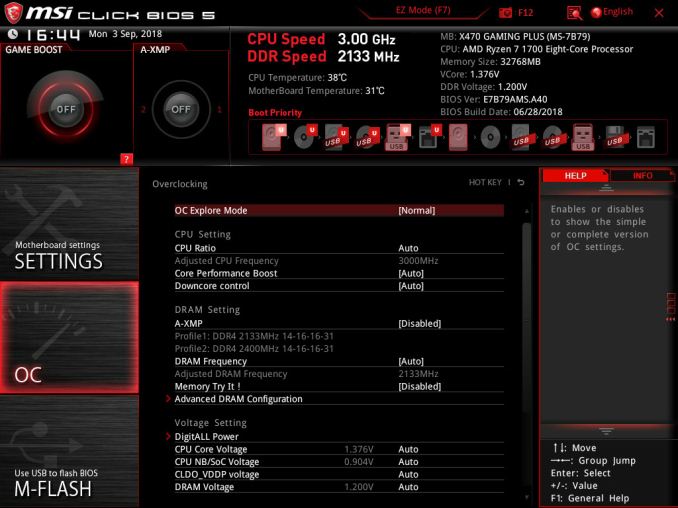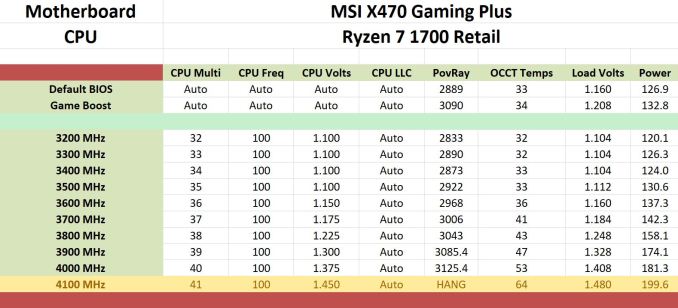The $120 MSI X470 Gaming Plus Review: Only 4-Phase VRM, Not 11-Phase as Advertised
by Gavin Bonshor on October 4, 2018 10:00 AM ESTRyzen Overclocking
Experience With the MSI X470 Gaming Plus
One of the most desirable aspects of the B and X marked AM4 socketed motherboards (B350, B450, X370 & X470) is that they have overclocking support with the entire range of Ryzen first and second-generation desktop processors as well as the Ryzen 2000 series APUs. Even though the MSI X470 Gaming Plus is targeted as an entry-level option for gamers to sink their teeth into, MSI’s decision to add an additional 4-pin 12 V ATX power input in addition to the 8-pin ATX connector most ATX sized boards feature means MSI has done one of two things. Firstly, it can signify that MSI is taking overclocking more seriously going forward that their entry-level model has more to offer for enthusiasts on a budget, or secondly that they thought it would increase the marketability to users who get dazzled into thinking more of something means better. Despite the fanfare given to something which isn’t even that important in the grand scheme of things, the MSI UEFI Click BIOS 5 interface is easy to use and users looking to avoid manually overclocking their CPU and memory can do so with the Game Boost button and the A-XMP buttons respectively. For a Ryzen 7 1700 processor such as the one we are using for the AM4 test bed, the settings applied using Game Boost are modest at best with an extra 200 MHz applied at a CPU VCore of 1.2 V. This equates to a maximum clock speed of 3.2 GHz under maximum load.
Users looking to make manual adjustments can find all the relative and useful settings regarding overclocking in the OC section with options such as CPU ratio which allows users to adjust the CPU core frequency up in 100 MHz increments. Voltage control is also adjustable and present with CPU core voltage and DRAM voltage being the most notable, but users using the Ryzen 2000 series APUs should note that the X470 Gaming Plus does include SoC voltage control through the CPU NB/SoC voltage setting.
Our Ryzen 7 1700 1000-series processor has a limit of around 4.0 GHz with a voltage range of 1.36-1.40 volts which is ultimately down to the quality of the silicon within. While there are Ryzen 7 1700 chips out there that have managed up to and including 4.3 GHz with ambient cooling, every piece of silicon reacts differently and is a consequence of what overclockers like to call ‘playing the silicon lottery’.
Methodology
Our standard overclocking methodology is as follows. We select the automatic overclock options and test for stability with POV-Ray and OCCT to simulate high-end workloads. These stability tests aim to catch any immediate causes for memory or CPU errors.
For manual overclocks, based on the information gathered from previous testing, starts off at a nominal voltage and CPU multiplier, and the multiplier is increased until the stability tests are failed. The CPU voltage is increased gradually until the stability tests are passed, and the process repeated until the motherboard reduces the multiplier automatically (due to safety protocol) or the CPU temperature reaches a stupidly high level (100ºC+). Our test bed is not in a case, which should push overclocks higher with fresher (cooler) air.
Overclocking Results
The X470 Gaming Plus did output a little more voltage than was requested within the BIOS for each 100 MHz strap on the CPU frequency with an incremental increase as the core frequency went higher culminating in a 0.03 V increase from 1.45 to 1.48 V at the 4.1 GHz; which was consequentially unstable anyway. The overclocking performance of the X470 Gaming Plus was positive with no serious voltage irregularity throughout the testing and POV-Ray performance was consistent aside from at 3.4 GHz where it fell short of what was expected; this is put down to an anomaly. At the maximum stable limit of our Ryzen 7 1700 processor the board put 1.408 V through the chip at maximum load with a set voltage in the BIOS of 1.375 V. It should also be noted that the single Game Boost setting provided seemed to provide the same level of performance as if the processor was set at 3.9 GHz manually which means that the 200 MHz increase over the default base core frequency of 3.0 GHz is boosting under load at 3.9 GHz at 1.208 V which is very respectable as far as automatic overclocking profiles go.












27 Comments
View All Comments
just4U - Friday, October 5, 2018 - link
There really doesn't appear to be a great deal of difference between the Plus and the supposedly better pro version of this motherboard.. and typically, the pro can be had for in and around the same price. I like their Pro Carbon board tho as it's just better all around with more features (better lan/sound to) that imo are worth the little extra you pay.I do have to say that I've been very impressed with MSI's Ryzen MB offerings. The 300 and 400 series have been problem free for me and performed like champs whereas I've had some issues with Gigabyte and Asus offerings in those chipsets.
Oxford Guy - Friday, October 5, 2018 - link
"MSI do include an 8-pin 12V ATX power input for providing power to the CPU as well as an additional 4-pin for users looking to overclock their processors."Buildzoid says these additional power connectors are useless for Ryzen, as I recall. It's not possible to draw more than one power connector can provide, particularly given the anemic VRM setup here.
"This board does have an additional 4-pin available on top of the 8-pin ATX 12 V CPU power input and MSI advertises an 11-phase power delivery under the heatsinks. Underneath the heatsinks, there is an 11-phase VRM present, but the real configuration is revealed in our visual inspection of the board."
Umm.... No.
ballsystemlord - Sunday, October 7, 2018 - link
Gavbon, all the AMD MBs you have reviewed are misrepresenting their amount of power phases AFAIK, is their any way for a consumer to check this before purchasing?Does/has the lack of power phases adversely affected the non-overclocked performance of AMD's top chips?
You see, I'm planning to upgrade next year, and I think that this is important.
Dr. Swag - Sunday, October 7, 2018 - link
For the most part it doesn't matter much unless you're doing extreme ocing. Anything 4 phases and higher with a heatsink is usually gonna be fine for a 6 core and for an 8 core preferably you'd like something a bit beefier to handle the extra power requirements without potentially getting too hot (a fake 8 phase like the gaming plus would probably be fine because the extra fets means more max power the vrm can supply and also greater surface area to dissipate heat through)29a - Sunday, October 7, 2018 - link
Why was the testing done with a 980 and a 1700?Lazlo Panaflex - Monday, October 8, 2018 - link
Agree with 29a. Why haven't you updated the test bed with (at least) a 2700? I doubt people buying these boards are paring them with 1st gen CPUs.Also, in the future could you disable Core Performance Boost and run some benches to see the difference in performance, please? FYI, My 2600 runs at 3.4 when it's disabled, and 3.9 when enabled; I have a MSI B450 Gaming Plus mATX.
Thanks
LP
Frenchyaz - Tuesday, April 9, 2019 - link
I've been so disappointed with MSI. I had a former generation 990FXA-GD80 and it has been rock solid from the get go. It had Military class 4 Caps and all bells and whistles.I got this board to upgrade along with a 2600X and the A2 Dimm port was dead, great. I returned the board and get another one after I called support and guess what, same Dimm port was also dead.
I returned the CPU and board, no more MSI for me.
So this board may be great when working but for me, I'll wait and will get a x570 when out, from Asus. Never had issues with Asus...we'll see.